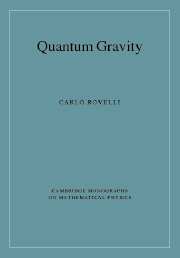7 - Dynamics and matter
Published online by Cambridge University Press: 06 July 2010
Summary
In the previous chapter, I constructed the Hilbert space and the basic operators of LQG. In this chapter I discuss the dynamical aspects of the theory. For this, we must write a well-defined version of the Wheeler–DeWitt equation (6.3) in order to construct the hamiltonian operator H.
The construction of the hamiltonian operator of LQG has taken a long time, proceeding through a number of steps. The first was to realize that the operator can be defined via a simple regularization and that any loop state Ψα solves HΨα = 0, provided that α is a loop without self-intersections. This observation opened the door to LQG. The result remains true in all subsequent definitions of H. With this first simple regularization, however, H diverges on intersections.
The second step was to realize that a finite operator H could be obtained provided that (i) its action is defined on diffeomorphism-invariant states and (ii) its density character is appropriately dealt with. By a sort of magic, the action of the operator with the correct density weight on a diff-invariant state converges trivially, in the limit in which the cut-off is removed. This result is the major pay-off of the background-independent approach to QFT. It is a manifestation of the relation between background independence and the absence of UV divergences.
- Type
- Chapter
- Information
- Quantum Gravity , pp. 276 - 295Publisher: Cambridge University PressPrint publication year: 2004
- 1
- Cited by



